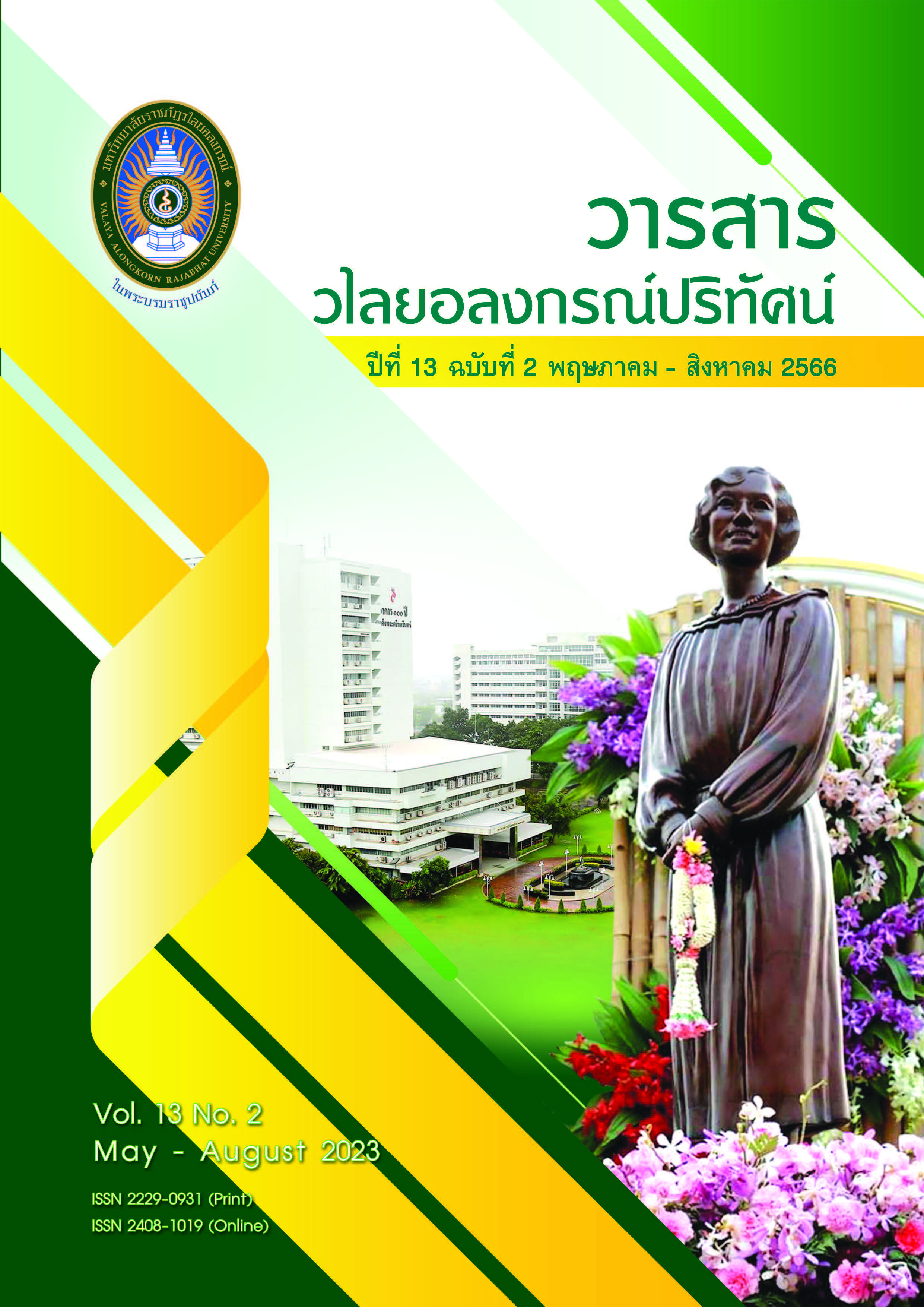THE RELATIONSHIP BETWEEN CRITICAL SUCCESS FACTORS OF LOGISTICS PROCESSES AND THE OPERATIONAL EFFICIENCY OF FOOD DELIVERY BUSINESS ON THE SITUATION OF COVID-19 IN PATHUM THANI PROVINCE
Keywords:
Critical Success Factor, OTOP Product, Efficiency, Mobile Application, COVID-19Abstract
The purpose of this research was to study: 1) the behavior of consumers who purchased products from online food delivery companies on the COVID-19 situation in Phatum Thani province. 2) relationship between the critical success factors of logistics processes and the operational efficiency of food delivery services. And randomly selected 385 consumers who purchased products from an online food delivery company on the COVID-19 situation in Phatum Thani province for collected data by questionnaires, and then the data were analyzed by using average, percentage, standard deviation, and Pearson product moment correlation. The research findings were as follows: 1) Most of the respondents were female university students, within the age range of 20–29 years old, and had a monthly income range of 10,000–20,000 baht. The most people use services from the Food Panda application the most, 43 percent, with the highest frequency of using the service 4-6 times per month, at an expense of 100–200 baht per time. 2) The results of the analysis of the success factors of the overall logistics process are very important. With an average score of 3.57, with the highest average being the support for customers factor and overall operational efficiency, which are very important. with an average score of 3.49, with the highest average being procurement. In addition, the relationship between the critical success factors of logistics processes and the operational efficiency of food delivery services found that the success factors of logistics processes related in a positive direction to the overall operational efficiency of food delivery services, with a correlation coefficient of 0.21 that was statistically significant at 0.01 levels, and the relationship between the critical success factors of logistics processes (rationality and timeliness) and the operational efficiency of food delivery services (satisfaction) was positive, with a correlation coefficient of 0.19 and 0.19, respectively that was statistically significant at 0.01 levels.
References
ชัชดาภรณ์ จอมโคกกรวด. (2564). ปัจจัยที่มีผลต่อการตัดสินใจเลือกใช้บริการจัดส่งอาหารในเขตพื้นที่อำเภอเมืองจังหวัดนครราชสีมา. วิทยานิพนธ์วิทยาศาสตรมหาบัณฑิต สาขาวิชาการจัดการโลจิสติกส์และโซ่อุปทาน มหาวิทยาลัยบูรพา.
ชลดา พุ่มกะเนาว์. (2558). ปัจจัยความสำเร็จของกระบวนการโลจิสติกส์ที่ส่งผลต่อประสิทธิภาพการดำเนินธุรกิจอาหารเสริม กรณีศึกษาผลิตภัณฑ์อาหารเสริมนิวทริไลท์. การค้นคว้าอิสระบริหารธุรกิจมหาบัณฑิต สาขาวิชาการจัดการวิศวกรรมธุรกิจ มหาวิทยาลัยเทคโนโลยีราชมงคลธัญบุรี.
ณัฐพงษ์ สีบุญเรือง, สัญจิตา พรมโชติ และ พิมพา หิรัญกิตติ. (2565). การศึกษาคุณภาพการให้บริการไรเดอร์เดลิเวอรี่ระหว่าง Grabfood กับ LINE MAN ในสถานการณ์โควิด -19 ของประชาชนในจังหวัดปทุมธานี. วารสารวิชาการสถาบันเทคโนโลยีแห่งสุวรรณภูมิ. 8(2): 256 - 270.
ณัธภัชร เฉลิมแดน. (2563). ศึกษาพฤติกรรมผู้บริโภคในการสั่งอาหารแบบเดลิเวอรี่ผ่านโมบายแอปพลิเคชันช่วงเกิดโรคติดเชื้อไวรัสโคโรนาสายพันธุ์ใหม่ 2019 ในเขตกรุงเทพมหานคร. วารสารบริหารธุรกิจอุตสาหกรรม. 2(1): 92 – 106.
พีระนัฐ โล่วันทา. (2564). การตัดสินใจใช้บริการ Food Delivery ของผู้บริโภคในจังหวัดเชียงใหม่. การค้นคว้าอิสระบริหารธุรกิจมหาบัณฑิต สาขาวิชาบริหารธุรกิจ มหาวิทยาลัยแม่โจ้.
ธัญลักษณ์ เพชรประดับสุข. (2563). ปัจจัยที่มีอิทธิพลต่อพฤติกรรมการใช้บริการสั่งอาหารผ่านแอพพลิเคชั่นบนสมาร์ทโฟนของผู้บริโภคในเขตกรุงเทพมหานคร. ปริญญานิพนธ์บริหารธุรกิจมหาบัณฑิต บัณฑิตวิทยาลัย สาขาวิชาการจัดการ มหาวิทยาลัยศรีนครินทรวิโรฒ.
วันวิสา วงศ์คำสาย, สุรีรัตน์ อินทร์หม้อ และ สุคนธ์ทิพย์ วงศ์พันธ์. (2565). ปัจจัยที่มีความสัมพันธ์กับการตัดสินใจสั่งอาหารโดยใช้แอปพลิเคชันบริการส่งอาหารของผู้สูงอายุในจังหวัดปทุมธานี. วารสารวิชาการการตลาดและการจัดการ มหาวิทยาลัยเทคโนโลยีราชมงคลธัญบุรี. 9(2): 140-158.
ศูนย์วิจัยกสิกรไทย. (2564). Food Delivery โควิด...ดันธุรกิจโตต่อ คาดปี 64 มูลค่าทะลุ 5.3 หมื่นลบ. ขยายตัว 18.4 - 24.4%. [ออนไลน์], เข้าถึงได้จาก:https://www.kasikornresearch.com/th/analysis/k-social-media/Pages/Food-Delivery-FB-24-08-21.aspx. (2564, 10 ตุลาคม).
พงษ์ชัย อธิคมรัตนกุล. (2550). โลจิสติกส์ก้าวย่างประเทศไทยในกระแสโลกาภิวัฒน์. กรุงเทพฯ: สำนักพิมพ์สุขภาพใจ บริษัท ตถาตา พับลิเคชั่น.
สำนักงานอุตสาหกรรมจังหวัดปทุมธานี. (2562). รายงานการวิเคราะห์สภาวะเศรษฐกิจอุตสาหกรรม. [ออนไลน์], เข้าถึงได้จาก: http://old.industry.go.th/pathumthani/index.php/2016-09-06-08-07-26/2016-09-06-08-09-08/23153-6-62-1/file. (2564, 2 มิถุนายน).
สมใจ ลักษณะ. (2549). การพัฒนาประสิทธิภาพในการทำงาน. กรุงเทพฯ: เพิ่มทรัพย์การพิมพ์.
อรรถพล ตรึกตรอง. (2554). การพัฒนาแผนกลยุทธ์แบบมีส่วนร่วมด้วยหลักฉลาดวางแผน (SMART Planning) เพื่อพัฒนาประสิทธิภาพของการจัดการเรียนการสอนตามหน่วยการเรียนรู้ แบบอิงมาตรฐานของโรงเรียนที่จัดการศึกษาภาคบังคับ 9 ปี. นครปฐม: สถาบันพัฒนาครู อาจารย์ และบุคลากรทางการศึกษา.
Best, J. W. (1977). Research in Education. (3rded). New Jersey: Prentic-Hall.
Khazanie, R. (1996). Statistics in a World of Applications. Fourth Edition. New York: Harper Collins College Publishers.
Marketingoops. (2564). เผยอินไซต์ Food delivery ช่วงโควิดระลอก 3 ‘ใครคือลูกค้าหลัก-เมนูไหนฮิต-ช่วงใดขายดีสุด’ และ ‘ร้านอาหารควรปรับตัวอย่างไร’. [ออนไลน์], เข้าถึงได้จาก: https://www.marketingoops.com/news/insight-food-delivery-covid-19/. (2564, 2 มิถุนายน).
Downloads
Published
How to Cite
Issue
Section
License
Copyright (c) 2023 วิญญู ปรอยกระโทก, นันทวัน แทนไทย, กุลบัณฑิต แสงดี

This work is licensed under a Creative Commons Attribution-NonCommercial-NoDerivatives 4.0 International License.
ข้อความที่ปรากฏในบทความแต่ละเรื่องในวารสารวไลยอลงกรณ์ปริทัศน์ เป็นความคิดเห็นของผู้นิพนธ์แต่ละท่าน มิใช่เป็นทัศนะและมิใช่ความรับผิดชอบของกองบรรณาธิการจัดทำวารสาร และ
มหาวิทยาลัยราชภัฏวไลยอลงกรณ์ ในพระบรมราชูปถัมภ์

